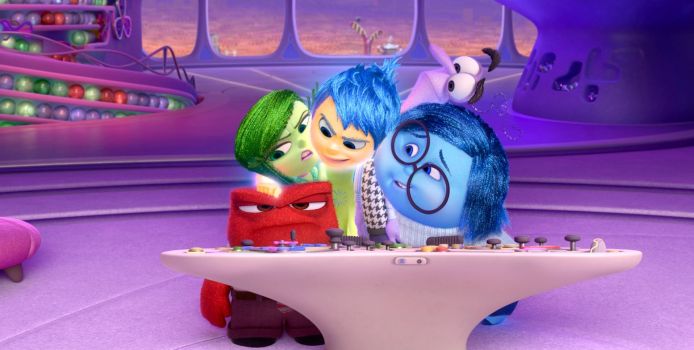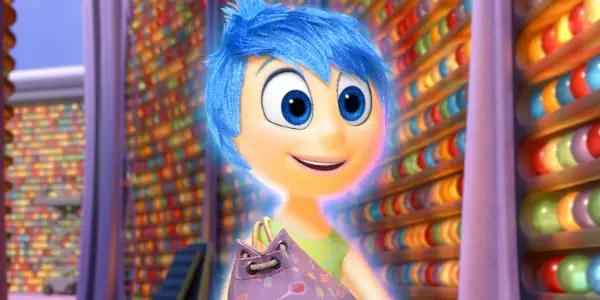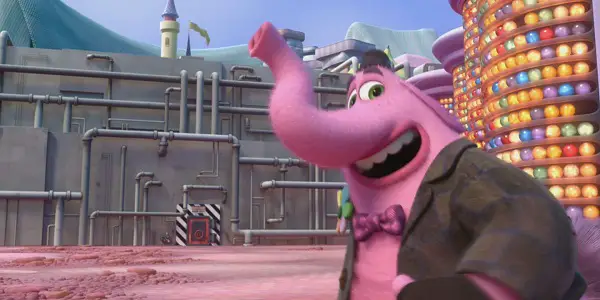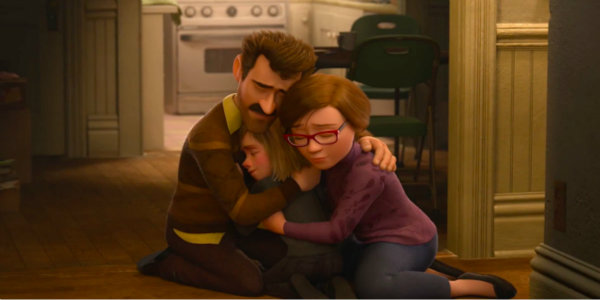INSIDE OUT: An Imaginative, Delightful Animation

David is a film aficionado from Colchester, Connecticut. He enjoys…
Inside Out is the latest in a long line of Pixar films that deal with the personification of something that you may have thought to be emotionless. Rather than bugs, toys, or fish this time, though, it is dealing directly with emotions themselves. What if the inner workings of our head were similar to an operational business, where our emotions literally guide and influence the actions in our daily life? It is a wonderful idea, and with Pixar’s usual gorgeous animation to back it up, it should prove to be a surefire hit for both kids and adults alike.
Voice acting and animation in its best form
Inside Out concerns a young girl named Riley (Kaitlyn Dias), and along with her family and friends, also shows the operations of her mind, which is governed by five core emotions: Joy (Amy Poehler), Sadness (Phyllis Smith), Anger (Lewis Black), Fear (Bill Hader), and Disgust (Mandy Kaling). Together, they decide the actions of Riley, including her words, her desires, and her memories, which serve as the basis for her personality. As Joy describes, they make Riley Riley. The main conflict that they deal with is Riley’s recent move from Minnesota to California, which serves to be a stressful transition in her life.

Joy is the leading emotion, and as a result Riley is mostly a happy girl. Something goes wrong, though, and both Joy and Sadness are swept up into the recesses of Riley’s mind, leaving Fear, Disgust and Anger at the controls (not the best combination, as you can imagine). Through their journey back to the helm, Joy and Sadness come to understand each other more, and why each has an important role to play. Both Amy Poehler and Phyllis Smith excel at their respective voice roles, truly embodying the emotions that they are meant to convey. Yet, ironically, they are also not written as shallow, one-note characters, showing by the end that even emotions can have emotions.
Pixar is always known for their beautiful animation, and here they may have outdone even their finest work of the past. From the design of the emotions themselves, who each represent what they are (Joy is a bright, glowing figure, Sadness appears to be a teardrop, and Anger is a red, fiery blob), to the design of her mind, which is itself similar to an amusement park with different islands of personality, each of which is operational at different points of Riley’s life. The only potential negative here is that, with such an emphasis on Riley’s mind, you really don’t see too much of the real world. You see where the two coincide, but really, most of the film is spent in her head. It’s not necessarily a bad thing, though, because the world of Riley’s mind is like none other that Pixar has created.
Will transform the way you think about thinking
What makes Inside Out one of Pixar’s more creative ideas is that it deals with something that everybody can clearly relate to, and presents it in a witty, clever way. For example, the train of thought in Riley’s mind is literally a train, which travels from one corner of her head to another at random. The dream workshop in her mind is set up similar to a theatrical production, with writers, directors, and a set crew, which recreate memories in Riley’s head while she sleeps.

And imagination island is where Riley’s wildest ideas come to life, including a part-cat, part-elephant, part-dolphin creature named Bing Bong (voiced by Richard Kind, a scene-stealer if there ever was one) that used to be her imaginary friend. There is also an Abstract Thought zone, which serves to create a new idea that Riley had never before considered. Here, in a new school with none of her old friends, it is the idea of loneliness. It’s no surprise that the film came from the mind of Pete Docter, who is also responsible for Monster’s, Inc. and 2009’s Up.
The personification of our everyday thoughts, which we usually don’t even notice, are here literally brought to life. For example, why we do suddenly get sad for no reason when we think of the past? Could it be because Sadness has accidentally touched a previously happy memory and tainted it into a sad one? Or why we do we suddenly get these crazy ideas in our head? It could be because Anger, Fear, and Disgust are at the controls, and are not able to think rationally without Joy and Sadness to back them up. It may not be very scientific, but it’s definitely more of a fun way to look at our minds than by trying to understand neurons and complicated brainwave activity.

For that reason, Inside Out will particularly appeal to children, many of which are going through the same teenager phase as Riley, or may have even undergone their own emotionally rough transitions, whether from a move, a divorce or something similar. And, through all of Inside Out’s eye-popping wonder, they may even come to understand something more about themselves, in that it is important to use all of your emotions, rather than pushing them away so that you feel nothing. At times, it’s important to be sad, because once you allow yourself to be sad, then you can finally be happy again; and that’s an important lesson for kids that are just beginning to shape into their mature, adult selves.
Conclusion
Above all, Inside Out is proof that Pixar is still capable of unique and wonderful ideas, even now, almost 20 years after the first Toy Story. With originality, lively animation, and some powerful heart-strung moments, it will make you feel the same way as the five emotions in Riley’s head, at least for a time (it’s mostly Joy, though, by the end). Although it’s only the middle of 2015, it’s my pick for best animation of the year. I really don’t see how any other film could top it.
(top image source: Walt Disney Studios Motion Pictures)
Does content like this matter to you?
Become a Member and support film journalism. Unlock access to all of Film Inquiry`s great articles. Join a community of like-minded readers who are passionate about cinema - get access to our private members Network, give back to independent filmmakers, and more.
David is a film aficionado from Colchester, Connecticut. He enjoys writing, reading, analyzing, and of course, watching movies. His favorite genres are westerns, crime dramas, horror, and sci-fis. He also enjoys binge-watching TV shows on Netflix.













